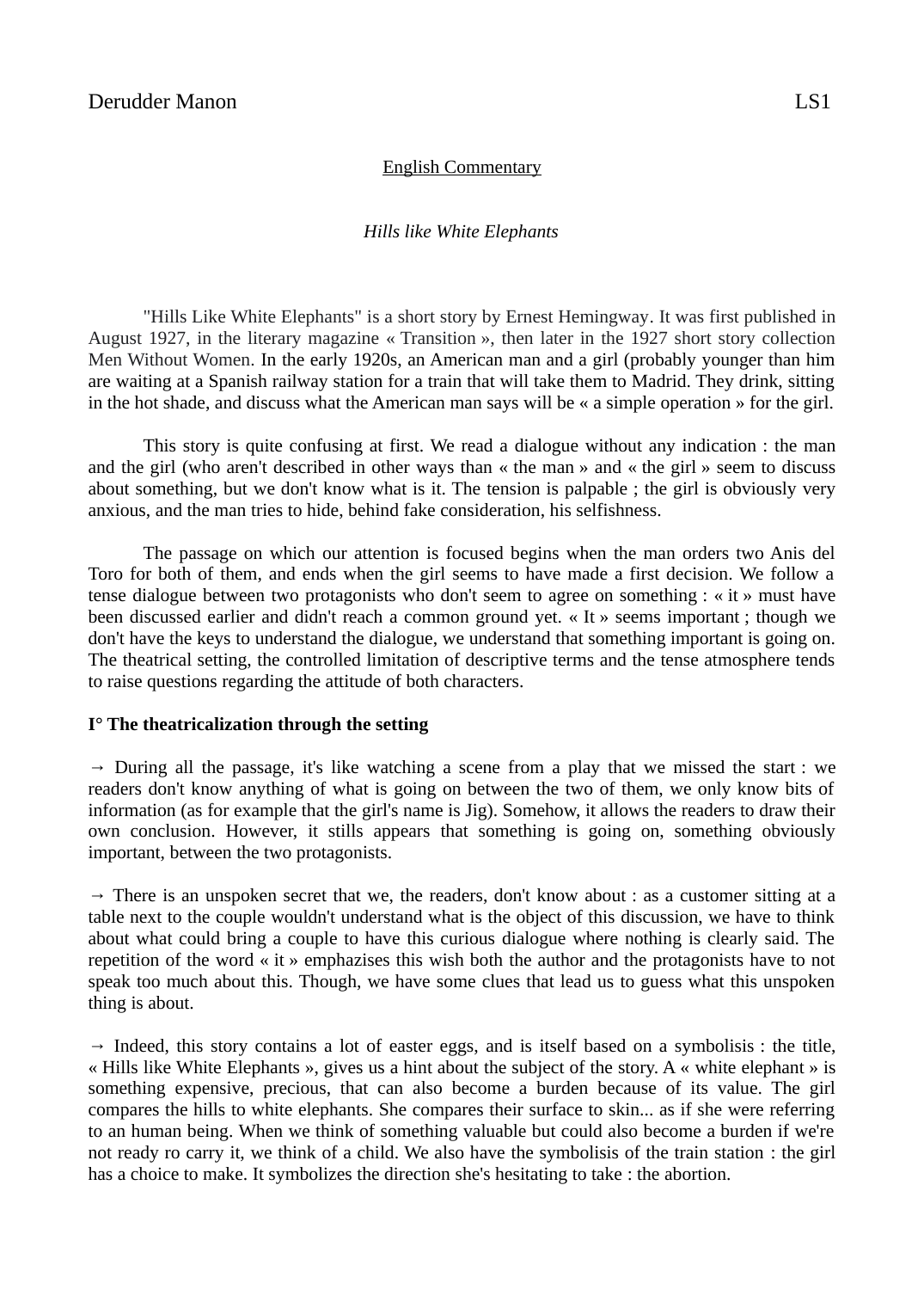hills like white elephants analysis
Publié le 20/03/2022

Extrait du document
«
Derudder Manon LS1
English Commentary
Hills like White Elephants
"Hills Like White Elephants" i s a short story by Ernest Hemingway .
It was first published in
August 1927, in the literary magazine « Transition », then later in the 1927 short story collection
Men Without Women.
In the early 1920s, an American man and a girl (probably younger than him
are waiting at a Spanish railway station for a train that will take them to Madrid.
They drink, sitting
in the hot shade, and discuss what the American man says will be « a simple operation » for the girl.
This story is quite confusing at first.
We read a dialogue without any indication : the man
and the girl (who aren't described in other ways than « the man » and « the girl » seem to discuss
about something, but we don't know what is it.
The tension is palpable ; the girl is obviously very
anxious, and the man tries to hide, behind fake consideration, his selfishness.
The passage on which our attention is focused begins when the man orders two Anis del
Toro for both of them, and ends when the girl seems to have made a first decision.
We follow a
tense dialogue between two protagonists who don't seem to agree on something : « it » must have
been discussed earlier and didn't reach a common ground yet.
« It » seems important ; though we
don't have the keys to understand the dialogue, we understand that something important is going on.
The theatrical setting, the controlled limitation of descriptive terms and the tense atmosphere tends
to raise questions regarding the attitude of both characters.
I° The theatricalization through the setting
→ During all the passage, it's like watching a scene from a play that we missed the start : we
readers don't know anything of what is going on between the two of them, we only know bits of
information (as for example that the girl's name is Jig).
Somehow, it allows the readers to draw their
own conclusion.
However, it stills appears that something is going on, something obviously
important, between the two protagonists.
→ There is an unspoken secret that we, the readers, don't know about : as a customer sitting at a
table next to the couple wouldn't understand what is the object of this discussion, we have to think
about what could bring a couple to have this curious dialogue where nothing is clearly said.
The
repetition of the word « it » emphazises this wish both the author and the protagonists have to not
speak too much about this.
Though, we have some clues that lead us to guess what this unspoken
thing is about.
→ Indeed, this story contains a lot of easter eggs, and is itself based on a symbolisis : the title,
« Hills like White Elephants », gives us a hint about the subject of the story.
A « white elephant » is
something expensive, precious, that can also become a burden because of its value.
The girl
compares the hills to white elephants.
She compares their surface to skin...
as if she were referring
to an human being.
When we think of something valuable but could also become a burden if we're
not ready ro carry it, we think of a child.
We also have the symbolisis of the train station : the girl
has a choice to make.
It symbolizes the direction she's hesitating to take : the abortion..
»
↓↓↓ APERÇU DU DOCUMENT ↓↓↓
Liens utiles
- Lord of the flies analysis
- WHITE ZOMBIE
- Forest Hills.
- Cotswold Hills.
- Chiens de chasse: West highland white terrier.


